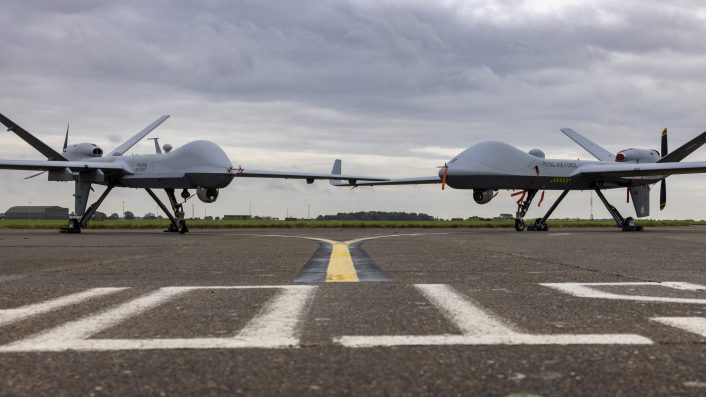The Royal Air Force has confirmed that its MQ-9A Reaper fleet has been withdrawn after 18 years in service, as the MQ-9B Protector RG1 readies for operational deployment.
Based entirely overseas for their entire service career, the Royal Air Force’s fleet of MQ-9A Reaper unmanned aerial vehicles (UAVs) have been one of the most widely used tools during the UK’s operations in Afghanistan, Iraq, Syria, and the wider Middle East. More than 173,000 hours were flown by RAF Reapers during these operations, with live airstrikes continuing alongside their intelligence, surveillance, and reconnaissance (ISR) mission through to this year.
We reported in September as the RAF announced it was preparing to deploy its new MQ-9B Protector RG1 – a development of the Reaper airframe – that the MQ-9A fleet had been subject an in-service support contract that had a listed expiry of Sept. 30, 2025. Despite some suggestion that this could be extended to cover any gap between the Reaper’s withdrawal and the Protector’s full introduction, it appears this option was not taken.
Aviation Week first broke the news of the type’s withdrawal on Sept. 30, with Janes following on Oct. 1. As both outlets mentioned, no official, public announcement was at the time available from the RAF or the wider Ministry of Defence regarding the MQ-9A’s sundown. An official announcement was eventually made on Oct. 3, with the caption of a photo of the Reaper and the Protector together confirming the last flight was on Sept. 30.
The Reaper was flown by the RAF’s 39 and XIII (13) squadrons. 39 Squadron was based alongside U.S. Reaper units at Creech Air Force Base, Nevada, until standing down in 2022, which left XIII Squadron, based at RAF Waddington, UK, to manage all continuing Reaper operations through to retirement.

Chief of the Air Staff, Air Chief Marshal Harv Smyth spoke about the MQ-9A’s withdrawal: “Over the last 18-years, the Reaper Remotely Piloted Air System has been the backbone of RAF operations in the Middle East. Its capabilities have been critical in supporting UK and Coalition forces, and it has made a significant contribution to the RAF’s ability to be Agile, Integrated and Ready to fly and fight. Amassing an astonishing number of operational flying hours, I am incredibly proud of all of the RAF personnel that have been involved in its highly skilled operation over so many years.”
Unlike the MQ-9A, the MQ-9B, or Protector RG1 as it is designated in UK service, has received a full military type certificate from the UK’s Military Aviation Authority. This permits the Protector RG1 fleet to operated in standard, unsegregated airspace alongside regular air traffic, thanks to the aircraft’s increased level of redundancies and additional systems fitted to the aircraft’s ground control stations (GCS). As such, Protector RG1s have been able to operate directly from their home base at RAF Waddington, while all RAF MQ-9 flights have been from overseas forward operating locations. From a central hub at Waddington, Protectors can be dispatched for operations worldwide through airlift and sealift, as well as offer support inside the UK to training exercises and to civilian agencies, if necessary.
The total number of MQ-9As in service with the RAF fluctuated over time due to a number of airframes being lost, and subsequently replaced, but the notional fleet comprised 10 aircraft. According to data from the UK Serials Resource Centre, 14 MQ-9A aircraft were assigned UK military serial numbers, two of which were known to have been written off and a further two reported as de-registered.
16 Protector RG1s have been ordered to replace the Reapers. As of the last update in June, four Protector aircraft have been delivered to RAF Waddington with six more airframes active in the U.S. for test and evaluation. The first operational unit to stand up with the Protector RG1 was 31 Squadron, known by their nickname ‘The Goldstars’. 31 Squadron previously flew Tornado GR4s up until their disbandment alongside the retirement of the Tornado in March 2019. Again unlike the Reapers, the Protector aircraft have, for now at least, been decorated with squadron markings. Alongside usual RAF policy these would likely be stripped before deploying overseas. It’s not clear when the first deployment will begin, or whether it has already begun without disclosure.
Entry into RAF service was formally declared in June 2025.
Protector RG Mk1, the UK variant of #MQ9B SkyGuardian®, has entered service with the @RoyalAirForce. The Protector program will deliver a cutting edge #RPAS for the UK, replacing the current Reaper® capability.https://t.co/LIWhDbIxqg#UAS #UCAV #UAV pic.twitter.com/sqKyNu1sgP
— General Atomics Aeronautical Systems, Inc (GA-ASI) (@GenAtomics_ASI) June 26, 2025
As with the MQ-9A, the MQ-9B carries an electro-optical/infrared camera turret and multi-mode radar as standard. Existing weapon types in use will be carried over, likely along with any podded ISR capabilities. Brand new capabilities are also in development for the MQ-9B, including airborne early warning (AEW) pods, airborne laser systems, and more. The aircraft has been ordered by a number of European countries, with the type’s designed suitability for unsegregated airspace being an attractive feature for smaller countries with much less of an ability to create large expanses of UAV specific airspace.
Full operating capability (FOC) for the RAF’s MQ-9B fleet is expected to be declared in 2026.